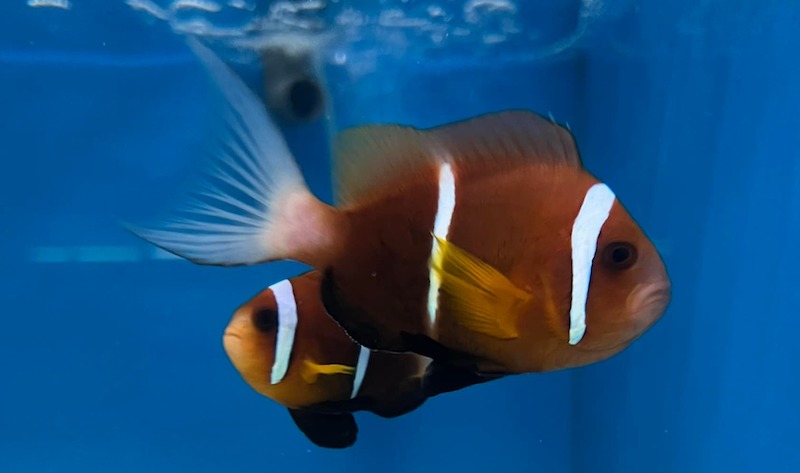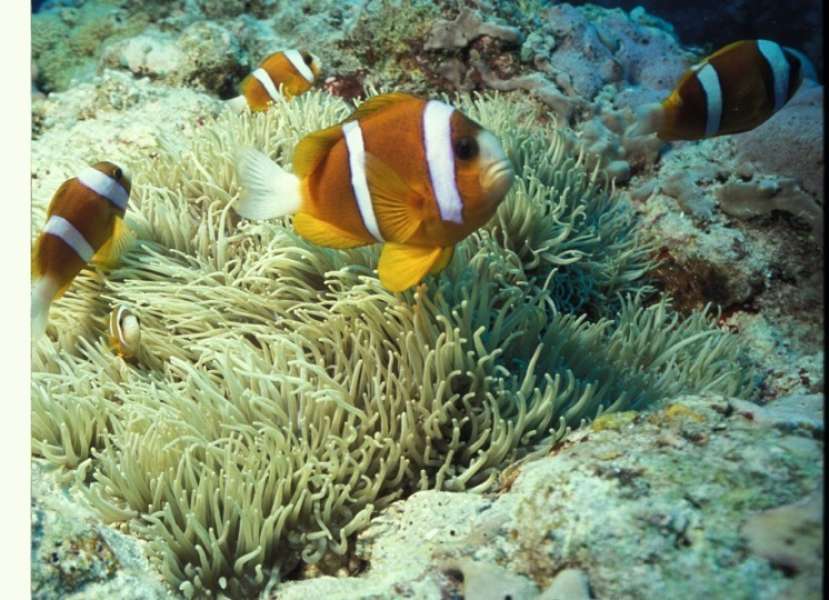Among the representatives of clownfish (Amphiprioninae) The Omani Clown (Amphiprion omanensis) differs in its large size, unusual color and limited habitat. You can meet it only in the coastal waters of Oman and the southern coast of the Arabian Peninsulawhich makes this species particularly interesting for scientists and aquarists.
📌 What makes an Omani Clown unique?
✔ The largest among all the clownfish-up to 18 cm
✔ Dark brown or reddish body with one white stripe
✔ A rare and poorly studied species, found only in Omani waters
✔ Close symbiosis with sea anemones
In this article, we will look at all the features Amphiprion omanensisfrom classification and appearance to lifestyle, breeding, and aquarium maintenance.

Scientific classification
✔ The Kingdom: Animals (Animalia)
✔ Type: Chordal (Chordata)
✔ Class: Lucheperi pisces (Actinopterygii)
✔ Row: Perch-like (Perciformes)
✔ Family: Pomacentrovye (Pomacentridae)
✔ Gender: Amphiprions (Amphiprion)
✔ View: Amphiprion omanensis
🔍 The species was described in 1991, making it one of the most recently discovered clowns.
Appearance and coloring
🎨 Key features:
✔ Dark brown, red-brown or even blackish body
✔ One wide white stripe behind the eyes, which often has a yellowish tinge
✔ The fins are dark, sometimes tinged with yellow
✔ The largest among all clowns-up to 18 cm
📌 The appearance of the Omani clown differs from the classic "Nemo" - it does not have three white stripes, but only one, and also has a more stocky structure.
Habitat and habitat
🌍 Where does it live?
✔ Exclusively in the Gulf of Oman and along the coast of Oman
✔ Reefs at depths from 2 to 15 meters
🏝 Typical biotopes:
✔ Inhabits surrounded by coral reefs and sandy lagoons
✔ Must interact with sea anemones
🌊 Symbiosis with anemones:
Like all clownfish, Amphiprion omanensis it lives in close symbiosis with anemones, which provide it with protection. Main types of partner anemones:
✔ Heteractis magnifica (Giant Anemone)
✔ Stichodactyla haddoni (Gaddon Anemone)
Lifestyle and behavior
🔹 Territoriality
✔ Live only within its own anemone
✔ Aggressive towards other fish approaching its territory
🔹 Social structure
✔ Lives with families - one female, one male and several smaller males
✔ The female is the largest in the group
🔹 Hermaphroditism
✔ When the female dies the largest male changes sex and becomes a female
Diet and nutrition
🍽 In the natural environment:
✔ Small crustaceans (mysids, copepods)
✔ Zooplankton
✔ Seaweed
🍽 In the aquarium:
✔ Live and frozen food (Artemia, moth)
✔ Granular and flake feed
✔ Herbal Supplements
📌 Omani clowns are less fastidious about their diet, but they need a balanced diet.
Reproduction and sexual dimorphism
🔹 Pack structure
✔ One female, one male and several younger individuals
✔ The female is the largest and most aggressive
🔹 Spawning
✔ Puts it off up to 1000 eggs near the anemone
✔ The male takes care of the eggs, providing ventilation
✔ Incubation continues 6-10 days
📌 After hatching, the larvae pass through the plankton stage, after which they settle among the reefs and look for anemone.
Keeping in the aquarium
🟡 Basic requirements:
✔ Aquarium capacity: from 200 liters
✔ Water temperature: 24–28°C
✔ Salinity: 1.020–1.025
✔ Filtering: powerful, with good circulation
🟡 Compatibility:
✔ Peaceful reef fish (gubani, surgeons, shrimps)
✔ Other big clowns (A. clarkii)
🟡 Incompatibility:
❌ Other clownfish species in the same aquarium
Great large carnivores ( triggerfish, moray eels)
📌 This species is quite hardy, but aggressive, so it is better to keep it either in pairs or with other large fish.

Threats and protected status
❗ Main threats:
✔ Destruction of coral reefs
✔ Catch for aquarium trade
🌱 Is it going to disappear?
✔ Population unknown, because the view is poorly researched
✔ Protected within Marine Reserves of Oman
📌 Due to its narrow range, this species is vulnerable to changes in the environment, so it needs monitoring and protection.
Conclusion
The Omani Clown – unique clownfish, which is the largest among all Amphiprion species. He rarity, great aggressiveness and beautiful coloring they make it particularly interesting for exploring and aquarium maintenance.
💙 If you are lucky enough to meet it in nature – it will be a real rarity! 🌊🐠